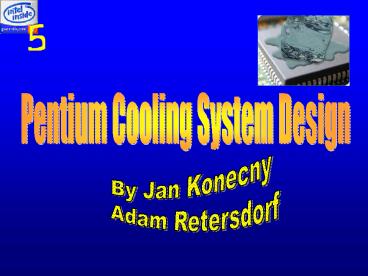Pentium Cooling System design - PowerPoint PPT Presentation
1 / 28
Title:
Pentium Cooling System design
Description:
Free and forced cases are housed inside the Plexiglas case ... state could be obtained easier using this system rather than an open table ... – PowerPoint PPT presentation
Number of Views:21
Avg rating:3.0/5.0
Title: Pentium Cooling System design
1
Pentium Cooling System Design
By Jan Konecny Adam Retersdorf
2
Pentium V Chip Cooling
- Quiet operation
- Reliable cooling
- Compact design
- Variable conditions
3
Natural Vs Free convection
- Natural Convection
- Forced Convection
4
Natural Vs Free convection
- Free Convection
- Very Quiet
- Low cost
- Efficient for low heat conditions
- Reliable
- Forced Convection
- Removes large quantities of heat
- Dependent on fan speed
5
Preference of cooling Options
- Least expense Natural Convection no sink
- Natural Convection W/ Sink
- Forced Convection no Sink
- Most expense Forced Convection W/ Sink
6
Experimental Setup
- Free and forced cases are housed inside the
Plexiglas case - Minimizes undesirable wind for Natural Convection
- Concentrates air velocity on chip for Forced
Convection
7
Experimental Setup
- Power source powered the fan and Chip Power
- K-Type Thermocouples
- Daq System (digital)
- Draft Reduced Laboratory
8
Reasons of Apparatus Setup
- Easy to record Temperature data over a given
amount of time - Steady state could be obtained easier using this
system rather than an open table - Represents the Closed Case computer housing
9
Measuring the Representations
- Ambient Temperature- simulates the air inside the
case - Chip Temperature- Lets us know the actual temp of
chip(/-2.2C) - Plexiglas Temperature- Represents the case
temperature
10
Measuring Heat Transfer
11
Knowledge of Pin Q loss
12
Heat transfer vs. Velocity Forced
13
Heat transfer Vs. P in Natural
14
Uncertainty analysis
15
Resistance of Case-Air
- Rcase-air ((Tmod-Tamb)/ Qconv
- Rcase-air Vs. Pin (Natural Convection)
- Rcase-air Vs. Air Velocity (Forced Convection)
16
R Vs. Pin Natural
17
R Vs. Air Velocity Forced Convection
18
First Order Approximation Analysis
- Forced Convection
- Determination of h value
- (from plot of h vs. air velocity)
- -Solving for chip temperature at different power
levels and different air velocities
19
Forced Convection
20
(No Transcript)
21
(No Transcript)
22
Estimated Temperature Vs. Velocity
23
Estimated Chip Temperature Vs. Power-in
24
Natural Convection
- Determination of h value (Extrapolation of the
data) - Solving for chip temperature at different power
levels
25
(No Transcript)
26
Spacing Recommendations(Liquid Crystal Imaging
system)
27
Recommendations
- Conservative approach
- 0 5W free convection with heat sink
- 5 15W forced convection without heat sink
- 15 30W forced convection with heat sink
- A Thermocouple controlled variable Speed fan
- Spacing air velocity recommendation
- (air velocities below 1.25m/s and above 3.5 m/s
provide for less than 30mm thermal wake length)
28
QUESTIONS
- ?































